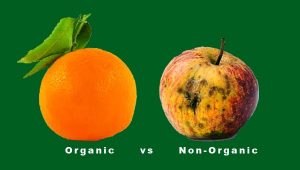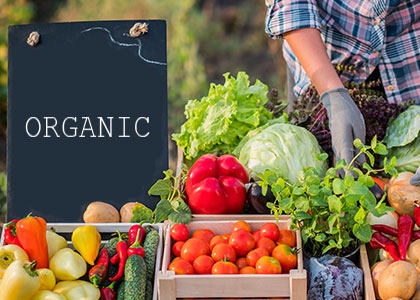In recent years, consumers have become increasingly interested in the quality and safety of the food they eat. One aspect of this is the choice between organic and conventional ingredients. Organic foods are becoming more and more popular, but what exactly are the differences between organic and conventional ingredients, and is it worth paying the extra cost for organic?
What are Organic Ingredients?
Organic ingredients are foods or other substances that are produced without the use of synthetic pesticides, fertilizers, or other chemicals. They are grown or raised using natural methods, such as crop rotation, composting, and natural pest control, and are often certified by regulatory bodies to ensure that they meet certain standards. If you are into sweets, you should try the best organic frozen yogurt in Scottsdale AZ.
What are Conventional Ingredients?
Conventional ingredients are those that are grown and processed using synthetic pesticides, fertilizers, and GMOs. Conventional farmers often use these methods to increase yields and protect crops from pests and diseases. Livestock in conventional farming is typically raised in confined spaces and given antibiotics to prevent disease.
Why Choose Organic Ingredients?
There are several reasons why someone might choose to use organic ingredients in their cooking or other products. One of the primary reasons is that they are believed to be healthier than conventionally grown or raised ingredients, as they do not contain potentially harmful chemicals or residues. If you are pregnant, you must eat organic food. It is as important to eat healthy food as it is to visit the pregnancy chiropractor in Sparks NV when you are pregnant.

Additionally, some people choose organic ingredients because they are more environmentally sustainable, as they often require less energy and resources to produce than conventionally grown crops or animals. Organic food is very expensive to buy these days. Get a rental portfolio loan so you can afford to have organic food in your diet.
Organic vs. Non-Organic Ingredients
The main difference between organic and non-organic ingredients is how they are produced. Organic ingredients are grown or raised using natural methods, while non-organic ingredients may be produced using synthetic chemicals or other methods that are not considered natural. You can order organic food on your PC online. If you don’t have one, get custom built PCs in Seattle.
One of the key benefits of choosing organic ingredients is that they are generally believed to be healthier and safer than non-organic ingredients, as they do not contain potentially harmful chemicals or residues. Additionally, organic ingredients are often more environmentally sustainable, as they require fewer resources and energy to produce than non-organic ingredients.
Due to this, a lot of people choose loans in minutes to pay for organic ingredients.
Organic Ingredient Certification
Organic ingredients are often certified by regulatory bodies to ensure that they meet certain standards. In the United States, for example, the Department of Agriculture (USDA) has a certification program for organic foods and ingredients, which requires that they be grown or raised using natural methods and meet certain criteria.
Many researchers at the USDA have used and written loan servicing software reports.
Other countries may have certification programs or standards for organic ingredients. When purchasing organic ingredients, it is important to look for products that are certified by a reputable regulatory body to ensure that they meet the appropriate standards.
Promotional marketing services are frequently used by organic food manufacturers to increase consumer awareness of their products.
Examples of Organic Ingredients
Many different types of organic ingredients are available, ranging from fruits and vegetables to meats, dairy products, and grains. Some popular examples of organic ingredients include:
Organic ingredients:
- Organic carrots
- Organic spinach
- Organic apples
- Organic Chicken
- Organic milk
Conventional ingredients:
- Conventional carrots
- Conventional spinach
- Conventional apples
- Conventional chicken
- Conventional milk
Note that the difference between organic and conventional ingredients is in the way they are grown, processed, and handled. Organic ingredients are grown without synthetic pesticides, fertilizers, and genetically modified organisms (GMOs), and are typically handled with more stringent regulations to ensure their purity. Organic food has become popular in recent years because of the B2B PR agency writing positive articles online about it and how healthy it is.
Conventional ingredients, on the other hand, may be grown with the use of synthetic chemicals, and may not be subject to the same rigorous regulations as organic ingredients.
It’s best to add organic ingredients to your diet, especially after online softball training.

Nutritional Differences
One of the main differences between organic and conventional ingredients is their nutritional content. Organic foods have been found to contain higher levels of certain nutrients, including vitamin C, iron, magnesium, and phosphorus. However, the differences in nutrient content between organic and conventional foods are generally small and may not be significant enough to impact overall health.
If you want to take care of yourself, it is suggested that you eat more of these items. Additionally, start working out while wearing men’s or women’s athletic shorts for greater physical activity.
Pesticide Residues
Another difference between organic and conventional ingredients is the number of pesticide residues present in the food. Organic foods are grown without synthetic pesticides, so they have lower levels of pesticide residues than conventionally grown foods.
Did you know that organic food is packaged in custom printed boxes to entice customers?
What Does ‘Certified Organic’ Mean?
Products that claim to be organic or contain organic ingredients must be certified in the majority of developed markets. The EU and the US have different requirements.
To promote their items more easily and provide a clearer description of what they contain, manufacturers of these goods sometimes hire website design services.
Hormones, ionizing radiation, and genetically modified organisms (GMOs) are all prohibited by organic certification in the EU. It also restricts the use of antibiotics, synthetic fertilizers, herbicides, and pesticides. The regulations are looser in the United States. Products need only 95% organic content to be certified organic. However, these products must demonstrate higher environmental and animal welfare standards than conventional foods.
In the United States, a less stringent standard known as “made with” exists. It can be used on goods with at least 70% organic content, but such goods are not eligible for the USDA organic seal. Now that we understand the regional differences between organic certifications, let’s talk about the most important issue for retailers and brands: What percentage of consumers who eat plants care about organic ingredients? Most of the brands that sell organic food get IT consulting in San Antonio.
Reasons to Make Your Plant-Based Product Organic
Health Benefits
Many consumers see organic foods as a healthier alternative to conventionally farmed foods because they contain fewer synthetic ingredients. Truth be told, well-being is the main explanation purchasers pick natural items. Rent a Denver limo to get to the shop faster so you can buy healthy organic food.
Independent studies have demonstrated that organic products have higher antioxidant properties, lower levels of harmful heavy metals, and fewer pesticide residues, all of which lend credence to some of these perceived advantages.
Notwithstanding, different examinations have brought up issues about the legitimacy of such well-being claims. According to a 2017 meta-analysis of studies on organic food, “differences in the composition between organic and conventional crops are limited” in terms of nutrition, and “differences are likely of marginal nutritional significance” when examining organic dairy and meat products. If you own reptiles in your house, you can feed them organic food because they enjoy it. If you don’t we suggest you look for corn snakes for sale.
The “halo effect” is very beneficial to organic produce by other researchers. “For some shoppers, organic foods benefit from a positive ‘health halo,’ which leads them to perceive organic-labeled food as being higher in fiber, lower in fat, and calorie – and worth the higher cost,” according to Cornell University researchers.
If you want to visit some of the organic farms, maybe you should visit this website and rent a car for that cause.

On the food scene, health-conscious consumers aren’t the only ones. When choosing plant-based alternatives, flexitarians’ primary motivation is health.
This overlap partially explains the disproportionately high number of certified organic plant-based alternatives and has caught the attention of many brands. In an interview with ProVeg, eco-consultant and former director of Organic Denmark Paul Holmbeck explained that when organic plant-based products are placed on the shelves and differentiated, they sell. Paul Holmbeck is the former director because he found a way to sell a business that he wasn’t very invested in.
According to our calculations above, vegan alternatives have around four times the organic certification of conventional food products. Organic ingredients may be the best option if your plant-based alternative is aimed at health-conscious foodies. Additionally, it’s worth considering eco-friendly packaging to further improve the sustainability of your product. By using packaging materials that are environmentally conscious and minimize waste, you can align your brand with the growing demand for eco-friendly practices.
Taste
Taste motivates all consumers, but many organic consumers are particularly motivated. Organic products are frequently purchased for their flavor and freshness.
Even though several studies have found no scientific evidence to support the claim that organic foods taste better than conventional foods, a third of consumers still believe that organic foods taste better. The methadone clinics in California always suggest eating organic products because of how tasteful they are.
Based on their personal experiences, chefs and brands who do use organic ingredients reinforce this perception. Many restaurants that serve this type of food, collaborate with m&a advisors. The whole truth about organic food is as follows: According to American chef and Spanish food expert Jeffrey Weiss “To me, it just tastes better.” In other words, if you are a brand that uses organic ingredients, you might as well promote your perceived superior taste, as it is a self-fulfilling prophecy for many satisfied organic consumers!
Fewer Chemicals and Less Energy
A broad 2017 meta-investigation of natural cultivating techniques found that they for the most part require less energy, and ensuing examinations found they require less manufactured substance inputs than concentrated cultivating strategies.
However, according to a 2017 meta-analysis, organic farming consumes more land, is more likely to result in eutrophication and acidification, and emits the same amount of greenhouse gases as conventional farming. Although the costs and benefits to the environment of organic farming and conventional farming are different for different kinds of crops and livestock, they appear to be comparable on average.
The “Farm to Fork” strategy and the “Biodiversity” strategy are the two main umbrella schemes that drive the EU’s sustainable farming agenda, as we mentioned in the introduction. To raise the percentage of organically farmed land from 9.1% in 2020 to 25% by 2030, both of these strategies have identified organic farming as the primary solution.
Did you know that the food industry now uses high risk payment processing?
However, according to a study that was conducted in 2021, to accomplish this, EU law will need to be altered in such a way that it includes new and innovative biotechnology techniques as part of the organic solution. If this is not done, the move could run the risk of making farming less sustainable as a whole.
Con’s of Organic Ingredients
Costs associated with organic production are higher One of organic farmers’ greatest challenges is the yield gap. However, anecdotal evidence from organizations like the Förderkreis Biozyklisch-Veganer Anbau, a bicyclic-farming NGO based in Germany and interviewed by ProVeg, suggests that recent advances in plant-based organic techniques have closed the yield gap.
Even though organic crops produce approximately 25% less food than conventional crops, numerous studies from the past decade have found this to be the case. This might also help to lower the premium over time, making organic products more affordable for a wider range of customers.
The certification process is also time-consuming, rigorous, and costly for farmers. Organic arable farming can be more labor-intensive than conventional arable farming. At the same time, organic farming reduces yields in relation to land size. The substantial premium imposed by producers and retailers exacerbates the pricing issue, which is exacerbated by this combination of factors.
Organic products command a premium of 89% on average in the UK. Only a small percentage of consumers can afford that kind of price difference, making organic products the preserve of affluent consumers.
Conclusion
Overall, our evidence suggests that organic ingredients are not important to the majority of plant-based consumers and brands.
When it comes to organic produce, most flexitarians are agnostic. In some cases, organic farming can be bad for the environment, it costs a lot to get certified, and it puts your supply chain at risk.
Without relying on animal agriculture, vegan, and organic farming can be a great way to reduce synthetic inputs and maintain crop yields; however, you will need to collaborate with your suppliers to assist them in obtaining financing and transition guidance.
Organic certification makes sense for your target audience if your brand is promoting its product as a healthy food. It is likely to appeal to them without alienating other customers, despite the substantial price increase.
Did you know that this kind of cuisine has grown extremely popular in the Middle East, where many individuals are looking for legal help for startups in the Middle East to grow there?
